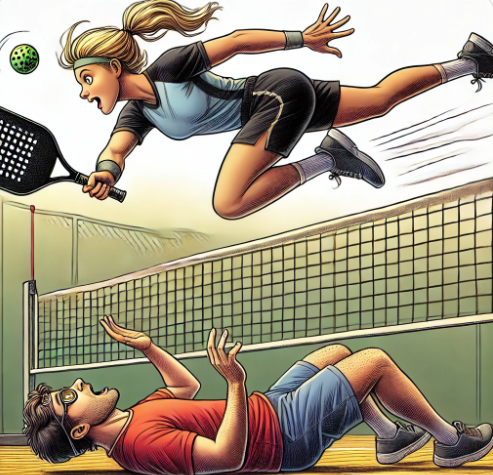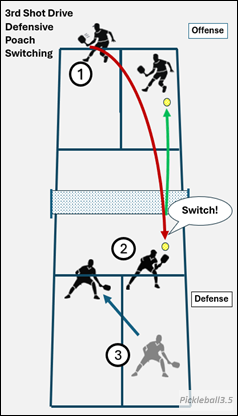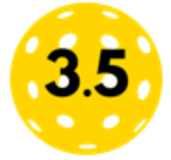
What Is Pickleball Poaching?
Pickleball poaching is when you boldly cross in front of your partner to take a shot headed their way. Think of it as a calculated court hijack—stepping in for the good of the team (or at least that’s how you’ll explain it later).
When Does Poaching Happen?
Poaching can occur in many game situations, especially when your partner is pushed back a bit and you slide in front to intercept the shot.
It’s most common when:
- You’re using your forehand: Poaching often involves stepping in with your forehand, taking over a shot your partner might otherwise play with their backhand.
- The shot is popped up: A popped-up ball gives you the perfect opportunity to step in and finish the point with authority.
Why Poaching Becomes Important at Higher Levels
As you advance towards and beyond the 3.5 skill level, poaching evolves from an instinctual reaction to a strategic tool. It’s no longer about bravado—it’s about maintaining your advantage on defense and neutralizing threats before they escalate.
Instinctive vs. Premeditated Poaching
Instinctive Poaching:
In many cases, poaching happens naturally during a rally, as the point unfolds and opportunities present themselves.
Premeditated Poaching:
Other times, poaching is planned in advance. One common scenario for premeditated poaching is:
- Defending the Third Shot: When you’re holding your ground at the net and your partner is still moving up after their return of serve, premeditated poaching can catch opponents off guard.
Poaching the Third Shot
Poaching the third shot is a surprise move designed to neutralize your opponents’ offensive play. Done well, it can disrupt a third-shot drive or drop aimed at your partner.
Recognizing When to Poach
You might notice a pattern in your opponents’ strategy:
- They consistently drive the third shot at your partner, targeting their slower pace or weaker positioning as they move to the kitchen line.
Rather than letting this happen repeatedly, you step in to change the narrative.
Planning the Poach
When you plan the poach, you’re compensating for an out-of-position or slower-moving partner. It’s a calculated move to keep your team in control of the rally.
After all, teamwork means stepping in to save the day when needed—and sometimes stealing a shot (with love, of course).
Poaching the Third Shot Scenario
In the illustration below the serve returner is slow to advance and the ball is driven back at them, their partner slides over and poaches the shot.

The serve is deep, and your partner hits the return from the baseline or maybe just behind it.
1. Your partner now must get to the kitchen line as quickly as they can. You know your opponent is likely going to drive it at them because they have a long distance to cover to get to the kitchen line.
2. Your opponent drives it at your partner. The third shot drive isn’t great and is floating a bit and moving relatively slow.
3. You anticipate the drive back at your partner. You slide over quickly in front of your partner to poach the drive, volleying it or smashing it back.
Be careful not to collide with your partner or take away their shot—it’s hard to look like a pro when you’re tangled up in a mid-court traffic jam. If your partner will reach the kitchen line in time to handle the drive, it’s best to resist the urge to poach.
Otherwise, you might irritate your partner by lunging onto their side of the court when they’re perfectly capable of making the play. Let’s face it, some players take poaching very personally. They might see it as you trying to take over the court because you think their play is weak, rather than understanding that poaching is simply part of playing at a higher level.
Pro Tip: If your partner gives you the side-eye after a poach, it’s time for a quick, humble explanation—or maybe a coffee bribe after the game.
Pickleball poaching is a judgment call, and with experience, you’ll develop a sixth sense for when it’s the right move. Remember, poaching is about strategy, not stealing the spotlight (though a little glory never hurts when it’s deserved).
Defensive Poach Switching
Switching is a critical part of pickleball. If you take over a spot on the court where your partner should be, they need to move where you were by “Switching”.
When poaching the third shot, you should switch if you move over into your partner’s court. If you only move a little, make the poach and slide back quickly.
Otherwise, shout out “Switch” to tell your partner you will stay, and they should move to cover the spot you left.
Poach Switching Scenario
In the illustration below the shot is poached and a switch is called out. The poaching player stays, and their partner moves over to cover where they were.

In the illustration:
1. Your opponent drives the 3rd shot at your partner.
2. You anticipate this and slide over quickly and poach the drive, volleying it or smashing it back. You are now in front of your partner and your spot is open. If your opponents can play your poached shot, they will try to put it in this open spot.
3. After you make the poach, yell “Switch” to tell your partner to move into your open spot. Your partner sees what you are doing, hears you and moves into the open position where you were.
Switching is a critical part of pickleball.
If you take over a spot on the court where your partner should be, they need to move where you were by “Switching”. Communication is crucial, always call out the “Switch”.
Sometimes partners will actually plan out the poach and switch. They do this by deciding ahead of time that the player at the net will attempt a poach on the third shot. The player advancing will then quickly move over to their side. This is a premeditated poach and switch.
Defensive Poach Mistake
Poaching the third shot is all about timing—and let’s be honest, when it’s off, it can be downright embarrassing.
If you move too early, before your opponent is set and swinging, they’ll have time to adjust and drive the ball into the open spot you just left. On a lofted, slow return shot, this is especially risky, as your opponent has more time to align their paddle and decide where to send the ball. If they have good racquet skills, they’ll gleefully change their aim at the last second and make you look like you just opened the door for them.
To avoid this, watch carefully and begin your movement just as your opponent starts their forehand swing. Once they’re committed to their swing, it becomes much harder (if not impossible) for them to change the direction of their shot.
With experience, you’ll get better at reading your opponents’ intentions, predicting their shot based on their paddle and body angle. Keep in mind:
- If the shot comes from your side of the court, moving too early makes it easy for them to exploit the open space behind you.
- However, if the shot is coming from the opposite side, it’s much harder for them to redirect to the open spot.
Pro Tip: Move too early, and it’s not just the point you lose—it’s your dignity when your opponents smirk after outmaneuvering you.
Another tactic to consider is the poach-fake. Make a quick movement to the side as if you’re about to poach, then return to your position. Your opponent will notice the fake and may panic, flinching or adjusting their shot at the last moment. This can lead to a mistake, giving you an edge without committing to the poach.
Pickleball Wisdom: A well-executed poach-fake can be just as satisfying as a successful poach—without the risk of leaving your partner high and dry.
Poach Mistake Scenario
In the illustration below the poach attempt is telegraphed and the player hitting the shot puts it behind the poacher at the last minute.

1. The serve is deep, and your partner hits the return from the baseline or maybe just behind it. Your partner’s return of serve is good, but they have a lot of distance to cover to get to the kitchen line. You sense your opponent is likely going to drive it at them because they haven’t gained the line.
2. You anticipate a drive return aimed at your partner and start to move over for an attempted poach.
3. Your opponent sees this and adjusts quickly to drive it down the line behind you. Timing is everything on a poach attempt, especially against experienced players. Don’t move too quickly on the poach or you will give it away and your opponent will see this and place their shot behind you.
Summary of Poaching in Pickleball
Be ready to poach a shot when the time is right. When positioned at the net at the start of a point, look to poach the third shot occasionally especially on a weak third shot or to make up for your partner not being able to advance quickly enough.

📘 Follow Pickleball35
Stay connected to Pickleball35 and follow our strategy content on Facebook!
Keep Learning
- Watch the video 🎥 below on Poaching.
- Read this post on Poaching Opinions: Poaching Opinions in Pickleball – What’s Your Opinion?
- Read the next post in the Third Shot series: How to Pinch the Middle in Pickleball
🎥Poaching Instructional Video
Courtesy of “The Pickleball Guy”
Watch this video on Pickleball Poaching on Youtube.
